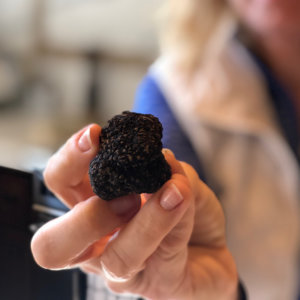 First Scientifically Cultivated Burgundy Truffle Harvested in America
First Scientifically Cultivated Burgundy Truffle Harvested in America
SONOMA COUNTY, Calif. (February 21, 2020) – Robert Chang, Managing Director and Chief Truffle Officer of American Truffle Company™ (ATC), the science-based cultivator of European black truffles in North America, is pleased to announce the first harvest of a Burgundy black truffle (Tuber uncinatum/aestivum) from the Otellini Truffle Orchard (OTO) in Sonoma County, California, on Friday, February 14, 2020. OTO had previously harvested its first Périgord black truffle in 2018.
Estate owner Sandy Otellini was notified of the truffle find by her orchard manager Chris Majcherek, who found the truffle during a routine orchard check with Dr. Bill Collins and his truffle dog, Rico, a Lagotto Romagnolo. “Robert Chang instructed me to immediately place it in a sealed jar with fresh eggs,” said Majcherek. “By the time Sandy returned home the next day, we had truffle-infused eggs ready to go!”
The truffle that Rico found weighed in at 24.5 grams, and was fully ripe and very aromatic. It was harvested from trees inoculated by ATC with the Burgundy black truffle fungus planted in 2011 by Sandy and her late husband, former Intel CEO Paul Otellini. The orchard management followed ATC’s strict scientific protocols tailored to the specific microclimate and soil conditions at OTO.
“We’re thrilled with the ongoing success of the Otellini Truffle Orchard,” says Chang. “This is to our knowledge the first harvest of a Burgundy truffle in California and the first scientifically cultivated harvest of such species in all of North America. It also demonstrates the reliability and reproducibility of American Truffle Company™’s scientific methodology and is indicative of future successes for all our North American truffle orchard partners. We look forward to many more harvests of both the Burgundy and Périgord black truffles, and to ramping up to commercial quantities to supply professional and home chef truffle enthusiasts alike.”
Prof. Paul Thomas, ATC’s Chief Scientist, viewing the truffle from his office in Scotland commented: “This is very exciting. The success of our scientific truffle cultivation technology now spans four continents. We’re looking forward to more harvests in North America as our truffle orchards steadily mature.”
To celebrate the harvest, Sandy Otellini invited Robert Chang to prepare her favorite truffle dish: pasta with butter—lots of butter—in a truffle egg yolk sauce. “It’s simply the best way to serve fresh truffles,” says Otellini. “The pasta in this rich sauce allows the truffle to shine.”
About European Black Truffles
European black truffles—both the Burgundy and the Périgord varieties—are not indigenous to North America. While the Périgord is the most expensive and sought after black truffle in the world, the Burgundy truffle also has significant culinary and economic value. Many of ATC’s partner truffle orchards are planted with both species to allow truffle harvests nearly year-round.
Burgundy truffles (Tuber uncinatum), grown mostly in the northern areas of Europe, are generally harvested from September to January and have more intense aromas than the genetically identical Summer truffles native to the Mediterranean climes. ATC’s Burgundy truffle trees are specifically inoculated only with the Burgundy variety that has a higher culinary and economic value to their Summer kin.
How Truffles Grow
Truffles are the fruiting bodies of a type of underground fungus that grows on the root system of living host trees. The fungi help host trees absorb nutrients more effectively, in return the host tree provides sugars and energy to the fungi. This relationship is called ‘mycorrhizal’ and is symbiotic. To grow truffles successfully, the fungus is introduced to the root system of host trees in a highly complex and technologically advanced inoculation process, and the resulting saplings are planted in a scientifically prepared field site. After planting, the orchards need to be carefully monitored and scientifically managed to ensure success. The most common host trees for truffle cultivation are various species of oak and hazelnut.


